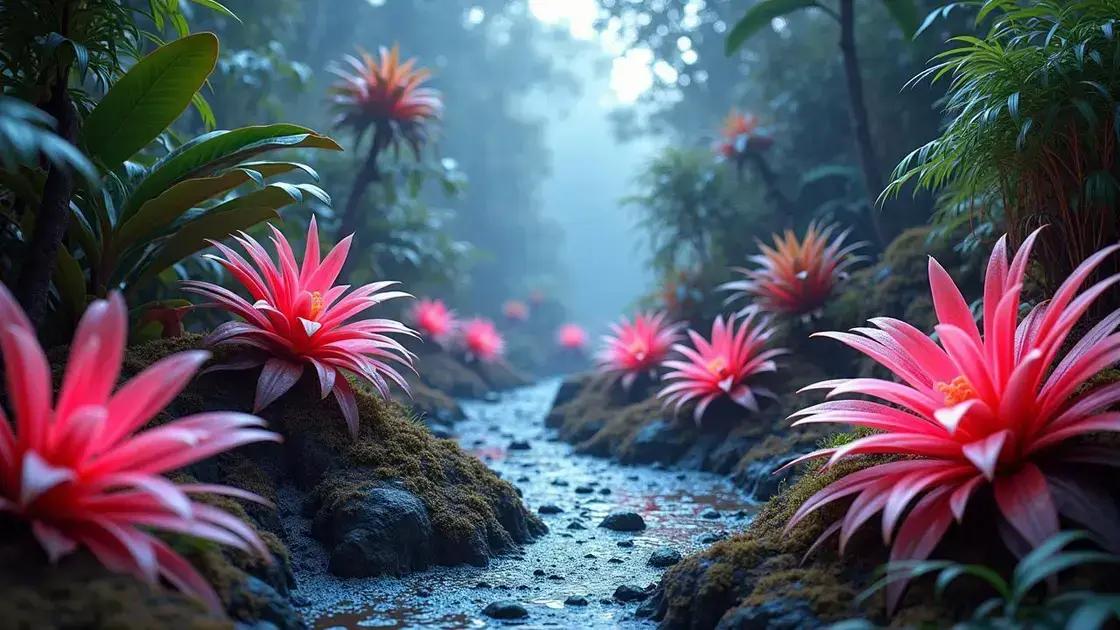How to care for bromeliad plant enthusiasts often wonder what secrets lie behind their vibrant colors and unique shapes. These stunning plants can brighten any space, but caring for them can be a bit tricky. Discover the essentials of bromeliad plant care that can help transform your home into a tropical paradise.
Table of Contents
ToggleUnderstanding bromeliad light requirements
Understanding bromeliad light requirements is essential for the success of your bromeliad plants. These stunning tropical plants thrive in bright, indirect light and can quickly decline if subjected to direct sunlight or insufficient light. In this guide, we will explore the light needs for bromeliads, ensuring they flourish in your indoor garden.
Optimal light conditions for bromeliads
- Bright, filtered light is ideal for most bromeliad species.
- Avoid direct sunlight, as it may scorch the leaves.
- Consider using sheer curtains to diffuse sunlight if placed near windows.
Types of bromeliads and their light needs
| Bromeliad Species | Light Requirement |
|---|---|
| Guzmania | Bright, indirect light |
| Aechmea | Moderate light |
| Neo-Regelia | Low to medium light |
Adjusting light conditions
- Observe the plant’s behavior: If leaves turn yellow, it may be getting too much light.
- If growth is weak or stretched, it may need more light.
- Rotate your bromeliads regularly for even light exposure.
To successfully grow bromeliads indoors, it’s important to understand the specific light requirements for the different species. For further insights, consider exploring indoor gardening techniques to enhance your plant care knowledge.
Gain insights on understanding bromeliad light requirements—optimal conditions for healthy growth and vibrant blooms.
Effective watering techniques for bromeliads

Effective watering techniques for bromeliads are crucial to their health and growth. These unique plants require a careful balance of moisture to thrive. Here are the best practices to ensure your bromeliads receive the proper hydration they need.
Watering methods for bromeliads
- Water the central cup: Most bromeliads have a rosette shape that collects water in the center. Fill this cup regularly.
- Use distilled or rainwater: Tap water may contain minerals that can harm these plants.
- Water the substrate: Ensure the soil remains moist but not soggy, allowing for proper drainage.
Understanding watering frequency
- Check the moisture level weekly: Use your finger to test the soil; it should feel slightly damp.
- Adjust according to season: Increase watering during the growing season (spring and summer) and reduce it during the dormant period (fall and winter).
- Avoid overwatering: Excess water can lead to root rot, a common issue for bromeliads.
Signs of proper watering
| Signs | Description |
|---|---|
| Vibrant leaves | Healthy, green foliage indicates good hydration. |
| Central cup retention | The water should be present in the central cup without decay. |
| No brown tips | Brown tips often point to underwatering or nutrient deficiencies. |
For more detailed guidance, consider exploring indoor gardening techniques that will help you master bromeliad care.
Master effective watering techniques for bromeliads to ensure vibrant growth and prevent common problems like root rot.
Common bromeliad care mistakes to avoid
Common bromeliad care mistakes to avoid can significantly impact the health of your plants. Identifying these mistakes is crucial for ensuring your bromeliads thrive. Here are the most frequent errors made in bromeliad care and how to steer clear of them.
Poor watering practices
- Overwatering can lead to root rot, a prevalent issue among bromeliads.
- Using hard tap water may create mineral buildup and damage the plants.
- Neglecting to water the central cup can result in dehydration.
Improper light exposure
- Placing bromeliads in direct sunlight can scorch their leaves.
- Insufficient light can lead to weak growth and a lack of vibrant color.
- Failing to adjust light conditions with the changing seasons may affect growth rates.
Incorrect potting mix selection
| Potting Mix Type | Common Mistake |
|---|---|
| Regular potting soil | Retains too much moisture, risking root rot. |
| Dirt-based mixes | Inadequate aeration for bromeliads. |
| Specialized orchid mix | Good choice for drainage and air circulation. |
The success of your bromeliads largely depends on avoiding common care pitfalls. For additional guidance, consider exploring indoor gardening techniques that will enhance your plant care skills.
Avoid common bromeliad care mistakes to ensure vibrant and healthy plants. Learn tips for better watering, lighting, and potting choices.
In conclusion
Caring for bromeliad plants can be a rewarding experience when you understand their unique needs. By mastering effective watering techniques, ensuring proper light conditions, and avoiding common care mistakes, you can nurture vibrant and healthy bromeliads that will beautify your indoor space. Remember, learning is part of the journey, so for more valuable insights, check out tips on enhancing your indoor garden.

